Ed. Note: Part two of this excellent series runs tomorrow at the same time. — J.N.
I will come right out and admit it. I am a geek. I am a hardcore geek. I revel in many different realms of geekdom. Amongst the fields where I am most comfortable with my geekdom is in comic books. I’ve been reading comics books since, well, I could read. During my early childhood, comic books were just entertainment, something to do when waiting at the supermarket whilst my mother shopped or to pass the time in line at the barber. There were the piles of Archie and Richie Rich comics that my grandparents stocked up on for the times a dozen grandkids would descend upon their house for summer vacation. In the end, I didn’t really care about comics themselves, just the ten minutes it would take me to read through whichever one was at hand. There was no appreciation of story arcs or pacing, art work and coloring, dialogue and continuity, all of these things were foreign concepts.
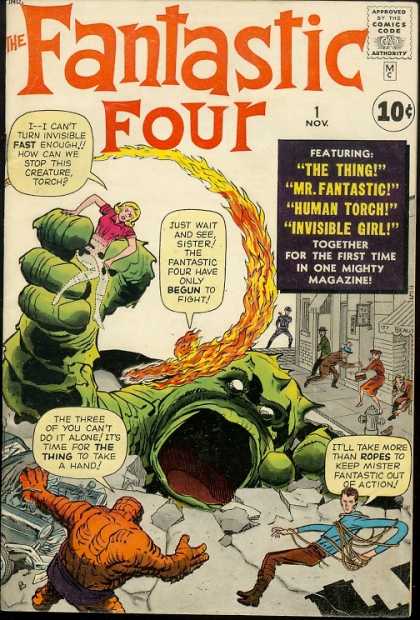
It wasn’t until I was about thirteen that a classmate of mine showed me that comic books were a world of their own. He had boxes and boxes of carefully stored books, each one in an individual bag with a cardboard backing to keep the spines straight. He was able to tell me about which stories were worth following, why Marvel characters were better than DC, and showed me where to go to get the best deals. I was hooked. From then on, I spent every spare penny of pocket money and any other money I earned on comic books. Throughout my high school years, I bought thousands of books, all still in their individual bags with cardboard backs, alphabetized, and organized by publisher.
The genre has changed dramatically since I started following it back in the 80s. It is, to some extent, still dominated by the two major players, Marvel and DC, each of which has its own diehard adherents, but there is now a plethora of thriving independent publishers, each one pushing the envelope in both art and with storytelling. More importantly the consumers have evolved. The geeks who grew up in the 80s, downtrodden and ridiculed by the jocks are the engine that drove the technological revolution of the 90s. They now find themselves hitting middle age flush with success at being the new arbiters of cool and that cool is the geekdom that they grew up loving; comics.
Over the next while, I would like to introduce the readers to this medium and to some of what I see as the more interesting and exciting offerings on the market today. Keep in mind, comic books are no longer reserved for kids. Many books are squarely aimed at the adult market. While there have always been those that were of a more prurient nature, today’s mature comics actually try to tell stories that evoke the same emotions and thoughts as other mediums have been doing for years. I want to share that love with you.
I will start with a brief history of what is referred to as Sequential Art.
Comics began in the late 1800s with single frames, in black and white as part of the Sunday editions of newspapers. The Katzenjammer Kids, first published in 1897 by Randolph Hearst was the first comic to be recognizable as such, a sequence of panels with balloon speech. As it happens, it’s still running today.
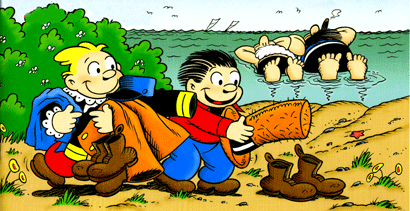
It would be another 30 years until the next major advance in comics would hit the scene. Following the rise of Science Fiction and Fantasy stories, pioneered by Edgar Rice Burroughs, 1929 saw the serialization of Buck Rogers in the 25th Century as well as the adaptation of Burroughs’ Tarzan. As the Great Depression took hold of America, many people turned to movies to escape their daily troubles, others went to comic strips. 1931 saw the genesis of the most popular comic strip character of all times, Dick Tracy and his two-way wrist radio. 3 years later, Flash Gordon came onto the scene.
Around the same time, 1933, the first comic book was published; a collection of comic strips put together in a folded multiple page format. The first book of all new content came out in 1935, put out by National Periodicals. The industry was starting to grow and experiment, and it was in 1938 that a strange visitor from another planet became the first in a pantheon of heroes with powers beyond the ken of normal man. Based on a series of stories they had written six years earlier, Jerry Siegal and Joe Shuster sold the rights to Superman to Detective Comics (later DC) for a whopping $130. With the advent of the Superhero genre, the industry moved from the serialized strip wholeheartedly into the comic book era. Comics were outselling even the most popular news weeklies, some moving two million copies per issue, a huge amount even by today’s standards. The era saw Will Eisner’s creation The Spirit published. As World War II began, the comic book industry joined the fight, Captain America burst onto the scene, famously punching Hitler in the face in 1941. A year later he was joined by Wonder Woman, whose alter ego Diana Prince was in the Women’s Auxiliary Corps.
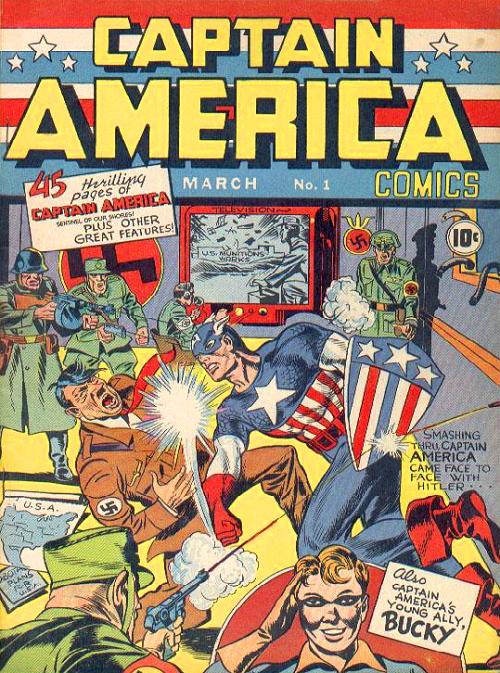
Also in the early 40s, another comic genre started to show up, one that wouldn’t really be noticed until after the war. True Crime comics, pioneered by Crime Does Not Pay, became the new rage. Lurid covers and graphic stories supposedly taken from the most violent police dispatches began to draw the largest audiences. True Crime was soon joined by Horror comics, both using drawings of scantily clad women on the cover to help move the product. As the fifties brought more and more horror comics into the market, each trying to outdo the next with their racy and macabre content, a backlash was building in Washington.
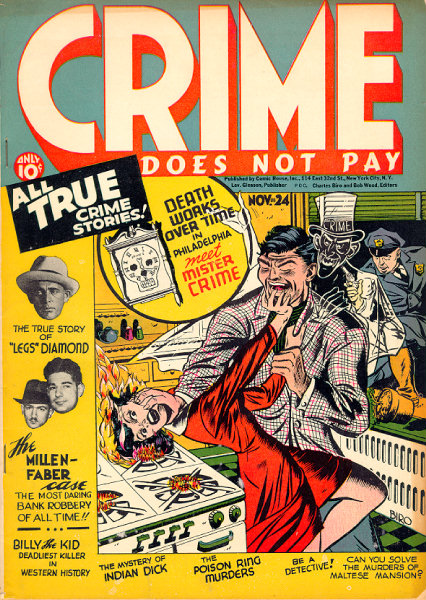
1953 saw the creation of the Senate Subcommittee on Juvenile Delinquency, chaired by Robert Hendrickson (R-New Jersey). It was founded to investigate the problems of, of course, juvenile Delinquency. Its 1954 hearings concentrated on the popular Horror and Crime genres. The committee released their findings , which were very critical of the industry. The direct result of this was the publication later that year by psychologist Frederic Wertham, of Seduction of the Innocent; a book that is the poster child for the Post Hoc Ergo Propter Hoc logical fallacy. Wertham argued that, since all delinquents read comic books, comic books cause delinquency. This caused a huge backlash against the comic community. Sales fell, books were burned and publishers went out of business. The industry, in a move aimed at salvaging what they could, instituted the Comics Code. Based on Hollywood’s Production Code, it was a self-censoring move to limit the graphic depictions of violence and sexual innuendo in comic books.
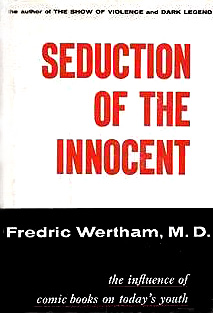
One of the results of the Code was that many of the smaller independent publishers went out of business. DC was one of the few companies to survive mostly unscathed with their stable of tame superhero books. Marvel, then called Atlas, barely survived and the only remnant of the house that brought forth the most graphic horror comics was MAD magazine. The late 50s and early 60s brought us many of the most iconic DC heroes. The Flash, The Green Lantern and The Martian Manhunter showed up, forming the Justice League along with veterans Wonder Woman and Aquaman.
The superhero genre was back, and it was back in a big way. In 1961, Jack Kirby joined Stan Lee and began publishing Marvel’s new brand of Super Hero starting with the Fantastic Four. The Marvel Age of comics was underway. The Fantastic Four was followed by the Hulk and Spider-Man a year later.
Next: Comics Move into the 70s and beyond
Cross-posted at JooFood
I will come right out and admit it. I am a geek. I am a hardcore geek. I revel in many different realms of geekdom. Amongst the fields where I am most comfortable with my geekdom is in comic books. I’ve been reading comics books since, well, I could read. During my early childhood, comic books were just entertainment, something to do when waiting at the supermarket whilst my mother shopped or to pass the time in line at the barber. There were the piles of Archie and Richie Rich comics that my grandparents stocked up on for the times a dozen grandkids would descend upon their house for summer vacation. In the end, I didn’t really care about comics themselves, just the ten minutes it would take me to read through whichever one was at hand. There was no appreciation of story arcs or pacing, art work and coloring, dialogue and continuity, all of these things were foreign concepts.
It wasn’t until I was about thirteen that a classmate of mine showed me that comic books were a world of their own. He had boxes and boxes of carefully stored books, each one in an individual bag with a cardboard backing to keep the spines straight. He was able to tell me about which stories were worth following, why Marvel characters were better than DC, and showed me where to go to get the best deals. I was hooked. From then on, I spent every spare penny of pocket money and any other money I earned on comic books. Throughout my high school years, I bought thousands of books, all still in their individual bags with cardboard backs, alphabetized, and organized by publisher.
The genre has changed dramatically since I started following it back in the 80s. It is, to some extent, still dominated by the two major players, Marvel and DC, each of which has its own diehard adherents, but there is now a plethora of thriving independent publishers, each one pushing the envelope in both art and with storytelling. More importantly the consumers have evolved. The geeks who grew up in the 80s, downtrodden and ridiculed by the jocks are the engine that drove the technological revolution of the 90s. They now find themselves hitting middle age flush with success at being the new arbiters of cool and that cool is the geekdom that they grew up loving; comics.
Over the next while, I would like to introduce the readers to this medium and to some of what I see as the more interesting and exciting offerings on the market today. Keep in mind, comic books are no longer reserved for kids. Many books are squarely aimed at the adult market. While there have always been those that were of a more prurient nature, today’s mature comics actually try to tell stories that evoke the same emotions and thoughts as other mediums have been doing for years.
I will start with a brief history of what is referred to as Sequential Art.
Comics began in the late 1900s with single frames, in black and white as part of the Sunday editions of newspapers. The Katzenjammer Kids, first published in 1897 by Randolph Hearst was the first comic to be recognizable as such, a sequence of panels with balloon speech. As it happens, it’s still running today.
It would be another 30 years until the next major advance in comics would hit the scene. Following the rise of Science Fiction and Fantasy stories, pioneered by Edgar Rice Burroughs, 1929 saw the serialization of Buck Rogers in the 25th Century as well as the adaptation of Burroughs’ Tarzan. As the Great Depression took hold of America, many people turned to movies to escape their daily troubles, others went to comic strips. 1931 saw the genesis of the most popular comic strip character of all times, Dick Tracy and his two-way wrist radio. 3 years later, Flash Gordon came onto the scene.
Around the same time, 1933, the first comic book was published; a collection of comic strips put together in a folded multiple page format. The first book of all new content came out in 1935, put out by National Periodicals. The industry was starting to grow and experiment, and it was in 1938 that a strange visitor from another planet became the first in a pantheon of heroes with powers beyond the ken of normal man. Based on a series of stories they had written six years earlier, Jerry Siegal and Joe Shuster sold the rights to Superman to Detective Comics (later DC) for a whopping $130. With the advent of the Superhero genre, the industry moved from the serialized strip wholeheartedly into the comic book era. Comics were outselling even the most popular news weeklies, some moving two million copies per issue, a huge amount even by today’s standards. The era saw Will Eisner’s creation The Spirit published. As World War II began, the comic book industry joined the fight, Captain America burst onto the scene, famously punching Hitler in the face in 1941. A year later he was joined by Wonder Woman, whose alter ego Diana Prince was in the Women’s Auxiliary Corps.
Also in the early 40s, another comic genre started to show up, one that wouldn’t really be noticed until after the war. True Crime comics, pioneered by Crime Does Not Pay, became the new rage. Lurid covers and graphic stories supposedly taken from the most violent police dispatches began to draw the largest audiences. True Crime was soon joined by Horror comics, both using drawings of scantily clad women on the cover to help move the product. As the fifties brought more and more horror comics into the market, each trying to outdo the next with their racy and macabre content, a backlash was building in Washington.
1953 saw the creation of the Senate Subcommittee on Juvenile Delinquency, chaired by Robert Hendrickson (R-New Jersey). It was founded to investigate the problems of, of course, juvenile Delinquency. Its 1954 hearings concentrated on the popular Horror and Crime genres. The committee released their findings , which were very critical of the industry. The direct result of this was the publication later that year by psychologist Frederic Wertham, of Seduction of the Innocent; a book that is the poster child for the Post Hoc Ergo Propter Hoc logical fallacy. Wertham argued that, since all delinquents read comic books, comic books cause delinquency. This caused a huge backlash against the comic community. Sales fell, books were burned and publishers went out of business. The industry, in a move aimed at salvaging what they could, instituted the Comics Code. Based on Hollywood’s Production Code, it was a self-censoring move to limit the graphic depictions of violence and sexual innuendo in comic books.
One of the results of the Code was that many of the smaller independent publishers went out of business. DC was one of the few companies to survive mostly unscathed with their stable of tame superhero books. Marvel, then called Atlas, barely survived and the only remnant of the house that brought forth the most graphic horror comics was MAD magazine[AH1] . The late 50s and early 60s brought us many of the most iconic DC heroes. The Flash, The Green Lantern and The Martian Manhunter showed up, forming the Justice League along with veterans Wonder Woman and Aquaman.
The superhero genre was back, and it was back in a big way. In 1961, Jack Kirby joined Stan Lee and began publishing Marvel’s new brand of Super Hero starting with the Fantastic Four. The Marvel Age of comics was underway. The Fantastic Four was followed by the Hulk and Spider-Man a year later.
[AH1]I don’t get it…MAD magazine made graphic horror comics? Or do you mean that the only remnant of the house that also brought forth the graphic horror was MAD?
COMMENTS
Please let us know if you're having issues with commenting.